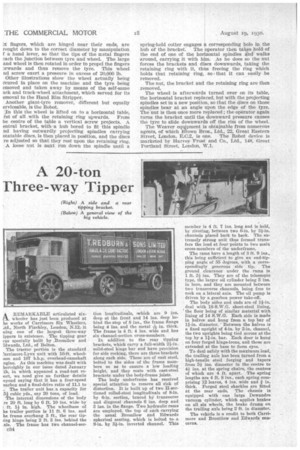A 20-ton Three-way Tipper
Page 56

If you've noticed an error in this article please click here to report it so we can fix it.
A •13.1.331ARICABLE articulated sixti._ wheeler has just been produced at he works of Carrimore Six Wheelers, Ad., North Finehley, London, N.12, it icing one of the largest three-way ippers in existence. The tipping gear vas specially built by ,Bromilow and Mwards, Ltd., of Bolton.
The tractor portion is the standard 7,arrimore-Lynx unit with 10-ft. wheelrase and 107 b.h.p. overhead-camshaft ngine. As this machine was dealt with horottghly in our issue dated January th, in which appeared a road-test reloft, we need give no further details .eyond saying that it has a four-speed .earbox and a final-drive ratio of 11.1 to . The trailer unit has a capacity for 5/ cubie yds., say 20 tons, of load. The internal dimensions of the body ye 20 ft, long by 6 ft. 10 ins, wideby ; ft. if in. high. The wheelbase of he trailer portion is 11 ft. 6 ins, and he frame overhang 3 ft, the rear tipjug hinge being 2 ft. 3 ins. behind the .xle. The frame has two channel-secc34 tiun longitudinals, -which are 9 ins. deep at the front and 14 ins, deep behind the step of 8 ins., the frame flange being 4 ins, and the metal qg in. thick. The frame is 4 ft. 4 ins, wide and has six channel-section cross-members.
In addition to the rear tipping brackets, which carry a full-width 21-in. solid-steel hinge bar and have provision for side rocking, there are three brackets along each side. These are of cast steel, bolted to the sides of the frame members so as to ensure a low loading height, and they mate with cast-steel brackets under the body-frame joists.
The body underframe has received special attention to remove all risk of distortion. It is built up of two H-sectoned rolled-steel longitudinals of 8-in. by 6-in. section' braced by transverse and diagonal channels 6 ins, deep and 3 ins, in the flange. Two hydraulic rams are employed, the top of each carrying the usual Bromilow and Edwards spherical seating, which is bolted to a 9-in. by 3/-in. inverted channel. This member is 4 ft. 7 ins, long and is held, by riveting, between two 6-in. by 3/-in. channels placed back to back. The extremely strong unit thus formed transfers the load at four points to two main cross-members of the underframe.
The rams have a length of 3 ft. 9 ins., this being sufficient to give an end-tipping angle of 55 degrees, with a correspondingly generous side tip. The ground clearance under the rams is 1 ft. 3/ ins. They are of the telescopic type, the larger oil cylinder being 5 ins. in bore, and they are mounted between two transverse channels, being free to rock on a lateral axis. The oil pump is driven by a gearbox power take-off.
The body sides and ends are of
deal with 18-S.W.G. sheet-steel lining, the floor being of similar material with lining of 14 S.W.G. Each side is made in halves and hung from a top bar of 11-in. diameter. Between the halves is a fixed upright of 4-in. by 2-in, channel, the two uprights being tied across at the top by a 1f-in. bar. Each door is hung on four forged hinge-irons, and these are extended at the base to form eyes.
To deal safely with the maximum load, the trailing axle has been turned from a high-tensile steel forging and tapers from 5i ins, diameter in the centre to ins, at the spring chairs, the centres of which are 4 ft. apart. The spring lengths are 4 ft. 8 ins., each spring comprising 12 leaves, 4 ins, wide and f in. thick. Forged steel shackles are fitted at the rear ends. The chassis is equipped with one large Dewandre vacuum cylinder, which applies brakes on all six wheels, the brake drums on the trailing axle being 2 ft. in diameter.
The vehicle is a credit to both Carrimore and Bromilow and Edwards concerns.












































































































